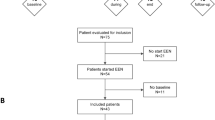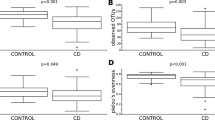Abstract
Background/Objectives:
Enteral feeding will induce remission in as many as 80–90% of compliant patients with active Crohn’s disease (CD), but its method of action remains uncertain. This study was designed to examine its effects on the colonic microbiome.
Methods/Subjects:
Healthy volunteers and patients with CD followed a regimen confined to enteral feeds alone for 1 or 2 weeks, respectively. Chemicals excreted on breath or in faeces were characterised at the start and at the end of the feeding period by gas chromatography/mass spectrometry.
Results:
One week of feeding in healthy volunteers caused significant changes in stool colour and deterioration in breath odour, together with increased excretion of phenol and indoles on the breath. Feeding for 2 weeks in patients with CD produced significant improvements in symptoms and a decrease in the concentration of C-reactive protein. The faecal concentrations of microbial products, including short-chain fatty acids (SCFAs), and potentially toxic substances, including 1-propanol, 1-butanol and the methyl and ethyl esters of SCFAs, showed significant falls.
Conclusions:
A significant change occurs in the production of microbial metabolites after enteral feeding in both healthy volunteers and patients with CD. Many of those detected in CD are toxic and may feasibly lead to the immunological attack on the gut microbiota, which is characteristic of inflammatory bowel disease. The reduction in the production of such metabolites after enteral feeding may be the reason for its effectiveness in CD.
This is a preview of subscription content, access via your institution
Access options
Subscribe to this journal
Receive 12 print issues and online access
$259.00 per year
only $21.58 per issue
Buy this article
- Purchase on Springer Link
- Instant access to full article PDF
Prices may be subject to local taxes which are calculated during checkout
Similar content being viewed by others
References
O’Morain C, Segal AW, Levi AJ . Elemental diet as primary treatment of acute Crohn’s disease: a controlled trial. BMJ 1984; 288: 1859–1862.
Middleton SJ, Rucker JT, Kirby GA, Riordan AM, Hunter JO . Long chain triglycerides reduce the efficacy of enteral feeds in patients with active Crohn’s disease. Clin Nutr 1995; 14: 229–236.
King TS, Woolner JT, Hunter JO . Dietary treatment of Crohn’s disease. Review article – the dietary management of Crohn’s disease ailment. Pharm Toxicol 1997; 11: 17–31.
Walker-Smith J . The role of enteral feeding in Crohn’s disease of childhood. Minerva Pediatr 2001; 52: 277–279.
Gupta K, Noble A, Kachelries KE, Albenberg L, Kelsen JR, Grossman AB et al. A novel enteral nutrition protocol for the treatment of pediatric Crohn’s disease. Inflamm Bowel Dis 2013; 19: 1374–1378.
Brown AC, Roy M . Does evidence exist to include dietary therapy in the treatment of Crohn’s disease? Expert Rev Gastroenterol Hepatol 2010; 4: 191–215.
Greenberg GR, Fleming CR, Jeejeebhoy KN, Rosenberg IH, Sales D, Tremaine WJ . Controlled trial of bowel rest and nutritional support in the management of Crohn’s disease. Gut 1988; 29: 1309–1315.
Teahon K, Pearson M, Smith T, Bjarnason I . Alterations in nutritional status and disease activity during treatment of Crohn’s disease with elemental diet. Scand J Gastroenterol 1995; 30: 54–60.
Lomer MC, Grainger SL, Ede R, Catterall AP, Greenfield SM, Cowan RE et al. Lack of efficacy of a reduced microparticle diet in a multicentered trial of patients with active Crohn’s disease. Eur J Gastroenterol Hepatol 2005; 17: 377–384.
Duchmann R, Kaiser I, Hermann E, Mayet W, Ewe K, Meyer zum Büschenfelde KH . Tolerance exists towards intestinal flora but is broken in active inflammatory bowel disease. Clin Exp Immunol 1995; 102: 448–455.
Van der Waaij LA, Kroese FG, Visser A, Nelis GF, Westenveld BD, Jansen PL et al. Immunogloblulin of faecal bacterial in inflammatory bowel disease. Eur J Gastroenterol Hepatol 2004; 16: 669–674.
Walton C, Fowler DP, Turner C, Jia W, Whitehead RN, Griffiths L et al. Analysis of volatile organic compounds of bacterial origin in chronic gastrointestinal diseases. Inflamm Bowel Dis 2013; 19: 2069–2078.
Bodelier AGL, Smolinska A, BAranska A, Dallinga JW, Mujagic Z, Vanhees K et al. Volatile organic compounds in exhaled air as novel marker for disease activity in crohn's disease: a metabolomic approach. Inflamm Bowel Dis 2015; 21: 1776–1785.
Hunter JO . Food allergy—or entero metabolic disorder. Lancet 1991; 338: 495–496.
Schofield WN . Predicting basal metabolic rate, new standards and review of previous work. Hum Nutr Clin Nutr 1985; 39C: 5–41.
Harvey RF, Bradshaw JM . A simple index of Crohn’s disease activity. Lancet 1980; 1: 514.
Shiga H, Jajiura T, Shinozaki J, Suzuki M, Takagi S, Kinouchi Y et al. Changes of faecal microbiota in Crohn’s disease treated with an elemental diet and total parenteral nutrition. Dig Liver Dis 2012; 44: 736–742.
Cummings JH, Hill MJ, Bone ES, Branch WJ, Jenkins DJA . The effect of meat protein and dietary fiber on colonic function and metabolism II Bacterial metabolites in faeces and urine. Am J Clin Nutr 1979; 32: 2094–2101.
Macfarlane GT, Cummings JH, Allison C . Protein degradation by human intestinal bacteria. J Gen Microbiol 1986; 132: 1647–1656.
Bamba T, Shimoyama T, Sasaki M, Tsujikawa T, Fukuda Y, Koganei K et al. Dietary fat attenuates the benefits of an elemental diet in active Crohn’s disease: a randomized controlled trial. Eur J Gastro Hepatol 2003; 15: 151–157.
Albenberg LG, Lewis JD, Wu GD . Food and the gut microbiota in inflammatory bowel disease; a critical connection. Curr Opin Gastroenterol 2012; 28: 314–320.
Sartor RB . Theraputic manipulation of the enteric microflora in inflammatory bowel diseases; antibiotics, probiotics and probiotics. Gastroenterology 2004; 126: 1620–1633.
Garner CE, Smith S, Costello BD, White P, Spencer R, Probert CSJ et al. Volatile organic compounds from feces and their potential for diagnosis of gastrointestinal disease. FASEB J 2007; 21: 1675–1688.
Rehman A, Lepage P, Nolte A, Helmig S, Schreiber S, Ott SJ . Transcriptional activity of the dominant gut mucosal microbiota in chronic inflammatory bowel disease patients. J Med Microbiol 2010; 59: 1114–1122.
Kaakoush NO, Day AS, Leach ST, Lemberg DA, Nielsen S, Mitchell HM . Effect of exclusive enteral nutrition on children with newly diagnosed Crohn’s disease. Clin Transl Gastroenterol 2015; 6: e71.
den Besten G, van Eunen K, Groen AK, Venema K, Reijngoud D-J, Bakker B . The role of short-chain fatty acids in the interplay between diet, gut microbiota, and host energy metabolism. J Lipid Res 2013; 54: 2325–2340.
D’Argenio V, Precone V, Casaburi G, Miele E, Martinelli M, Staiano A et al. An altered gut microbiome profile in a child affected by Crohn’s disease normalized after nutritional therapy. Am J Gastroenterol 2013; 108: 851–852.
Roediger WE . Oxidative and synthetic functions of n-butyrate in colonocytes. Dis Colon Rectum 1992; 35: 511–512.
Acknowledgements
This work was supported by the Wellcome Trust (Grant no. 080238Z/06/Z).
Author information
Authors and Affiliations
Corresponding author
Ethics declarations
Competing interests
Professor JO Hunter has received grants for research and honoraria for speaking from both Nutricia UK and Nestle UK. The other authors declare no conflict of interest.
Rights and permissions
About this article
Cite this article
Walton, C., Montoya, M., Fowler, D. et al. Enteral feeding reduces metabolic activity of the intestinal microbiome in Crohn’s disease: an observational study. Eur J Clin Nutr 70, 1052–1056 (2016). https://doi.org/10.1038/ejcn.2016.74
Received:
Revised:
Accepted:
Published:
Issue Date:
DOI: https://doi.org/10.1038/ejcn.2016.74



